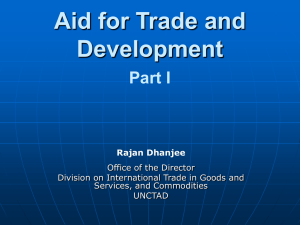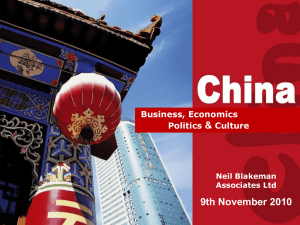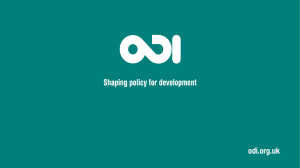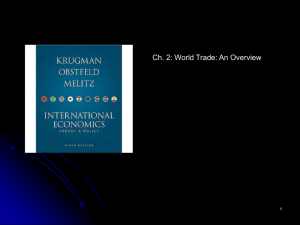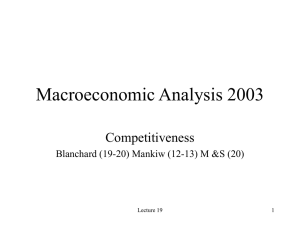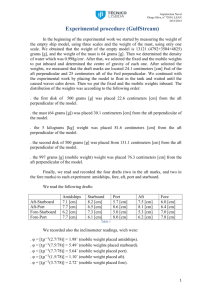Aid-for-Trade on exports - World Bank Internet Error Page
advertisement
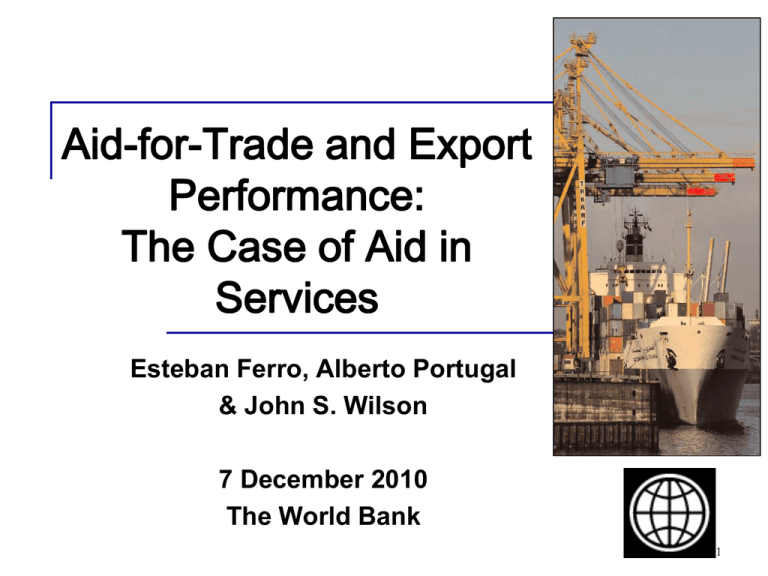
Aid-for-Trade and Export Performance: The Case of Aid in Services Esteban Ferro, Alberto Portugal & John S. Wilson 7 December 2010 The World Bank 1 Outline 1. 2. 3. 4. 5. Motivation Literature review Identification strategy. Data and Results Final Remarks 2 2 1. Motivation Aid for Trade (AfT) is a “high level” initiative initiated by the WTO/OECD: “Aid for Trade aims to help developing countries, particularly least-developed countries, develop the traderelated skills and infrastructure that is needed to implement and benefit from WTO agreements and to expand their trade”. Scant evidence on the impact of AFT on export performance in developing countries. 3 Aid for trade popular among donors and multilateral agencies… 1st Global Review of Aid-For-Trade (Geneva 2007) Heads of multilateral agencies: From left to right: Luis Alberto Moreno, IADB - Edouard Dayan, UPU - Dominique Strauss-Kahn, IMF - Rajat Nag, ADB - Patricia Francis, ITC - Abdoulie Janneh, UNECA - Pascal Lamy, WTO - Angel Gurría, OECD - Valentine Rugwabiza, WTO - Kemal Dervis, UNDP - Robert Zoellick, World Bank - Juan Somavia, ILO - Donald Kaberuka, AfDB 4 AFT through Time 19 90 19 91 19 92 19 93 19 94 19 95 19 96 19 97 19 98 19 99 20 00 20 01 20 02 20 03 20 04 20 05 20 06 20 07 20 08 0 5,000 10,000 15,000 20,000 25,000 Aid for Trade (1990-2008) AFT_infrastructure AFT_regulation AFT_capacity Source: estimates from OECD-CRS database. 5 Correlation of AFT and Exports (1) 25 30 20 Industry Aid vs. Industry Exports (1990-2008) 25 20 20 15 Fitted values' R =0.171 15 ln_aid 10 10 2 5 5 ln(exports) 15 ln(exports) 25 30 AFT_Total vs. Exports (1990-2008) 5 10 15 20 ln_aid 2 Fitted values' R =0.033 6 Correlation of AFT and Exports (2) Total AFT/GDP vs. Exports/GDP (2008) 8 30 AFT_Total vs. Exports (2008) BLZ 7 CHN MYS GNQ TTOAGO LBY THA OMN BRB ATG KNA LBR VUT GUY 5 6 PNG VNM SLB TGO CRI GAB SUR TCD GIN SYC NGA CHL DZAECU PHL HND NIC VCT ZAF SWZ TUN BOL CIVLSO CHN ZAR IDN ATG PRY MOZ DJI PAN JOR MEX ZMB GHA DMA LAO ARG SDN PER CMR MAR URY MUS NAM GTM LKA BWA INDFJI BRB SLVEGY JAM SLE COL BGD KEN TUR MDV BTN BRA WSM KNA DOM KIR SEN MDG PAK LCA LBN TZA BEN CAF MWI NPL UGA COM GMB GRD BFA RWA TON NER 4 20 OMN TTO GNQ ln(exports / GDP) 25 MEX MYS BRATHA IDN IND TUR ZAF ARG CHL DZA NGA PHL AGO LBY VNM COL PER EGY ECU MAR CRI TUNPAK BGD SDN COG GAB GTM DOMPNG CIVLKA URY PAN JORHND BOL KEN CMR PRY TCD GHA SLV ZMB ZAR MOZ LBN JAM NIC BLZ MUSBWA NAM GIN LAO TGO SEN TZA SUR SW Z GUY LBR NPLMDG UGA FJI BEN LSO VUT SYC BFA SLB MWI SLE DJI VCT NER MDV RWAMLI CAF BTNGNB LCA DMA WSM BDI GMB CPV GRD COM COG TONKIR BDI CPV MLI 3 15 GNB 12 14 16 18 20 22 0 1 ln_aid 2 Fitted values R =0.151 2 ln(aid / GDP) 3 4 2 Fitted values R =0.067 Potential reverse causality: does Aid cause exports? or does exports cause Aid? 7 code/ sector name Infrastructure 210 Transport & Storage 220 Communications 230 Energy Production Capacity 240 Banking & Financial Services 250 Business & Other Services 311 Agriculture 312 Forestry 313 Fishing 321 Industry Agro-industries Wood industries Textiles Chemicals Non metallic products Basic Metals Non-ferrous metals Machinery Transport equipment Energy manufacturing Industrial policy, , R&D 322 Mineral Resources & Mining Trade Policies and Regulations Total 1990-2008 2008 Disburs. (USD mill) Disburs. (USD mill) 114,118 57% 13,112 51% 61,633 31% 7,494 29% 7,508 4% 461 2% 44,977 22% 5,157 20% 82,101 41% 11,982 46% 13,053 7% 2,892 11% 9,319 5% 1,943 8% 32,163 16% 4,668 18% 4,567 2% 534 2% 2,836 1% 341 1% 15,561 8% 1,362 5% 821.20 0.4% 86.16 0.4% 240.26 0.1% 2.48 0.0% 100.39 0.1% 9.86 0.0% 2,125.18 1.1% 45.27 0.2% 324.50 0.2% 0.84 0.0% 253.02 0.1% 1.87 0.0% 28.45 0.0% 0.27 0.0% 352.35 0.2% 22.90 0.1% 622.52 0.3% 2.76 0.0% 670.49 0.4% 1.45 0.0% 8,681.74 4.7% 844.20 3.8% 4,602 2% 241 1% 4,378 2% 795 3% 200,596 100% 25,888 100% 8 2. Literature review Aid-for-Trade on exports Helble, Mann & Wilson (2010) Brenton & von Uexkull (2009) Cali & Te Velde (2009) AfT on trade costs (DB: time/container cost, #documents) : Busse et al. (2010): Cali and te-Velde (2009) Aid Effectiveness: large literature, ex Rajan & Subramanian (2009 & forthcoming) Brueckner (2010) 9 3. Identification Strategy Problem: potential reverse causality Biased estimates Potential IV for AFT: civil liberties, immunization rates, gender health access? IV at country level. Limited instruments. Identification strategy: exploit Aid on services. use US I-O data on intensity of services on downstream goods. 10 Estimation ln Exp ijt ij it jt k k ServiceInt ensity ki ln AFTService kjt ijt i: industry (Agro-ind, Wood-ind, Textiles, Chemicals, Non metallic prod., Basic Metals, Nonferrous metals, Machinery, Transport Equip.) j: exporter( aid recipient): 106 countries Total requirement of services k in dollar of manufacture i Aid in Services k k: services (Transport & Storage, ICT, Energy, Banking & Financial Services, Business Services) t: year:1990-2008 11 Data OECD-CRS database: disbursed flows of AFT from 33 donors (including multilateral donors) over 1990-2008. Input-Output Total Requirement tables production required, directly and indirectly, from each industry & commodity to produce a dollar of final good. 12 Results Table 1- Impact of aid to services on manufacturing exports 1 ln(trade) trans_int X aid_trans ict_int X aid_ict energy_int X aid_energy bank_int X aid_bank 2 ln(trade) 3 ln(trade) 4 ln(trade) 0.21 [0.154] -0.259 [0.383] 0.549** [0.243] 1.018* [0.556] 5 ln(trade) 6 ln(trade) 7 ln(trade) 0.13 [0.155] -0.231 [0.381] 0.817*** [0.169] -0.959* [0.569] 0.483* [0.247] 1.716*** [0.269] 0.912* [0.560] 2.482*** [0.788] bus_int x aid_bus 0.351 0.371* 1.349*** [0.222] [0.220] [0.334] Country-Sector Effect Yes Yes Yes Yes Yes Yes No Country-Year Effect Yes Yes Yes Yes Yes Yes Yes Sector-Year Effect Yes Yes Yes Yes Yes Yes Yes Observations 17678 17678 17678 17678 17678 17678 17678 R-squared 0.95 0.95 0.95 0.95 0.95 0.95 0.82 Robust standard errors in brackets. * significant at 10%; ** significant at 5%; *** significant at 1%. Dependent variable is ln( exports). Service sector intensities are estimated using US Total Input Requirements. 13 Results Table 2- Impact of aid to services on manufacturing exports Robustness Checks trans_int X aid_trans ict_int X aid_ict energy_int X aid_energy bank_int X aid_bank bus_int x aid_bus Observations R-squared Baseline 1 0.13 [0.155] -0.231 [0.381] 0.483* [0.247] 0.912* [0.560] 0.371* [0.222] 17678 0.95 ARG_Intensities 2 0.015 [0.168] 0.156 [1.493] 0.491*** [0.183] 3.453** [1.452] -0.679*** [0.252] 17678 0.95 By income level Year>1999 3 0.343 [0.267] -1.617** [0.807] 0.819** [0.393] 2.691*** [0.906] -0.211 [0.342] 9480 0.96 low 4 0.062 [0.361] 0.64 [0.749] 0.575 [0.503] 1.743 [1.095] -0.371 [0.435] 6298 0.92 mid-low 5 -0.15 [0.290] -0.417 [0.580] 0.800* [0.478] 1.457* [0.809] 0.541 [0.437] 6185 0.96 mid-high 6 0.551** [0.225] -1.357** [0.690] 0.059 [0.333] 0.088 [1.085] 0.856** [0.414] 3998 0.97 Robust standard errors in brackets. * significant at 10%; ** significant at 5%; *** significant at 1%. Dependent variable is ln( exports). Service sector intensities are estimated using US Total Input Requirements except for column (2) where Argentina’s Total Input Requirements are used. All regressions control for country-sector, country-year, and sector-year effects. 14 Final Remarks and Future Research Extend the input-output linkages to estimate: Impact of aid on additional upstream sectors (other than services) On exports of downstream goods (other than manufactures) Implement the identification strategy with country-specific Input-Output matrices. Additional robustness checks (lags of aid, samples of countries, years) 15 To be continued… Many thanks! 16 Identification Strategy Aid to Service Sectors (Inputs) 210 - Transport and Storage 220 - Communications 230 - Energy 240 - Banking and Financial Services 250 - Business and Other Services Export Performance in Manufacturing - Agro-industries - Wood-industries - Textiles - Chemicals - Basic Metals - Non-Ferrous Metals - Machinery - Transport Equipment - Non-metallic mineral products 17


